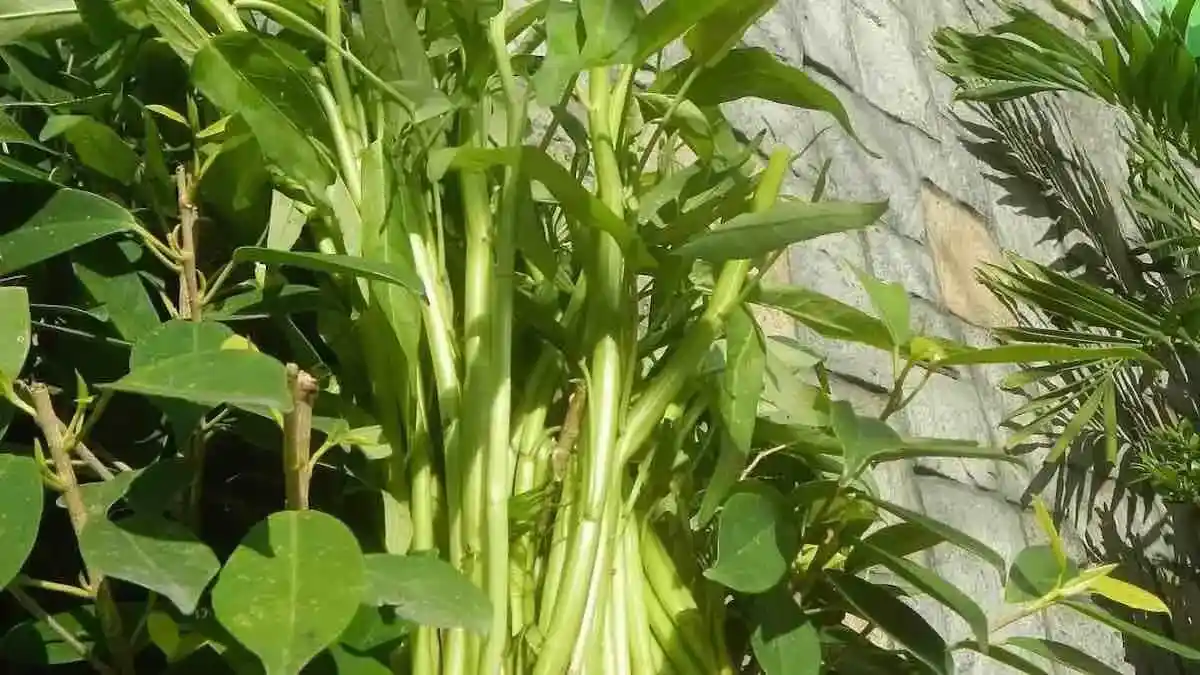Table of contents
Introducing Kangkong
Kangkong growing is easy because this semi-aquatic tropical plant (Ipomoea aquatica) is a water spinach that loves the tropical heat.
This plant is also known as Chinese watercress or swamp cabbage. Hence it originated from Southeast Asia. It is called ong choy (蕹菜) in Cantonese, and kōngxīncài (空心菜) in Mandarin.
Kangkong Growing Season
This plant loves heat and humidity. Consequently in the tropics kangkong grows all year round.
Kangkong Growing in Pots
We recommend growing in pots or containers. There are a number of reasons to do this, including the capacity to control your kangkong and stop it spreading.
In some areas this plant is regarded as a noxious weed, because it can block waterways. For this reason alone it is a good idea to grow it in a container that will not allow it to spread into any nearby waterways. Check with your local authorities and find out if this is the case in your area. If it is, simply grow your kangkong in a container.
Kangkong Growing Zone
Kangkong grows best in tropical and subtropical regions. It thrives in areas that are warm and humid, and it can be grown year-round in tropical climates.
In Australia it thrives in Tropical and Subtropical areas with temperatures between 20°C and 35°C (68°F to 95°F) and does best in wet and waterlogged conditions, which is why it often grows near water bodies. In the USA kangkong grows well in Zones 9 to 11, where temperatures rarely drop below freezing.
Kangkong Growing Conditions
Position your plants in full sun where you can supply water, because you need to keep the ground damp. Alternatively, you could also find somewhere the ground will hold at least some water naturally for these plants.
Kangkong Growing from Seed
Time needed: 4 minutes
How to Grow Kangkong from Seed.
- When to plant.
This plant can be grown from seed all year round in the tropics. However, you may want to plant it once the wet season starts, so less watering is required.
- Sow seeds
Sow seeds 1cm deep. Firm down gently and keep moist. Sow your seed either into seed trays or direct into the containers where the Kangkong is to be grown. Grow your seedlings 15-20cm (6-8in) apart.
- Sun and Water
Plant in full sun and water regularly. Remember, this plant is described as a ‘water spinach’ so it needs a lot of water, especially during the dry season.
- Harvesting
Harvest with scissors making sure you cut at least 10cm (4in) from the ground. This allows the plant to grow more green growth for you to enjoy.
How to grow Kangkong in Water
The easiest way to grow kangkong is in a bottle or jar full of water. Simply place your cutting in the water, ensuring two of the nodes are underwater.
Within a matter of days, you will see thin white roots growing from the nodes. Once the new roots are well established you can either transplant your kangkong into soil or continue growing in water.
How to Grow Kangkong from Cuttings
Kangkong is very easy to grow from cuttings. Cuttings of three or more nodes can be planted, making sure at least one node is under the soil surface. Keep the area around the plant moist and free of weeds.

How to grow Kangkong in soil
Kangkong is most often grown in soil by gardeners keen to produce crops of this vegetable for market.
Fertilising
Kangkong loves to be fed. A liquid fertiliser, chook manure or cow manure will boost growth rates.
Pruning / Harvesting
You need to harvest kangkong before it flowers. Cut off the leaves with a pair of scissors. Leave about 10cm (4in) and it will regrow so you can harvest again. So Kangkong is a gift that keeps on giving!
Watering
Kangkong prefers damp conditions. Consequently, it loves the banks of streams and wetlands. Indeed the green hollow stems will float on top of water or creep along damp ground.
Kangkong Growing Problems
In some areas kangkong is notified as a ‘noxious weed’ which means you must take care you grow it so it does not spread into the local environment. The other problem can be pests and diseases.
Pests and Diseases
Kangkong is more pest resistant than most other leafy greens. Grasshoppers and caterpillars are pests that can become a problem in the dry season. However, healthy planting material and good growing conditions can reduce any impact from these pests.
Regular application of ‘white oil’ can help address some of these pests. Indeed white oil is an effective organic pesticide that you can make at home.
Eating Kangkong
You can eat kangkong raw or cooked. Like most greens, it’s high in iron, but it’s not the slightest bit bitter, so you can use it in anything from stirfries to salads.
It is very versatile and can be boiled, blanched, or steamed. So Kang Kong has a wide variety of uses. Indeed, it can be added into curry sauces, as a soup vegetable or added into a stir fry.

Health Benefits of Kangkong Growing
Kangkong is a nutrient-dense vegetable that offers a range of health benefits due to its rich vitamin, mineral, and antioxidant content.
Weight Loss
Eating kangkong can help you lose weight. It is very low in calories and also increases you feelings of being full.
Fibre
This is a vegetable high in dietary fibres and is known to help prevent constipation.
Immune System
Kangkong is rich in Vitamin A. Consequently it is known to boost the immune system.
Antioxidants
This vegetable is high in antioxidants, which fight free radicals in the body. Consequently, they help the body to combat heart disease, cancer and other diseases.
Prebiotics
Kangkong contains pre-biotic fibre. This is a type of fibre that must go though you undigested. Further, this is know to improve your gut health and promote ‘good’ bacteria. Consequently, it can also help people who suffer from constipation.
All the best with your Kangkong Growing.
Other Tropical Vegetables
- Capsicum
- Cucumber
- Eggplant
- Jicama
- Malabar Spinach
- Pak Choi
- Perpetual Spinach
- Pumpkin Growing
- Snake Beans
- Sweet Potato
- Tatsoi



Comments
5 responses to “Kangkong Growing Guide”
[…] Kangkong […]
[…] Kangkong […]
[…] Kangkong […]
[…] Kangkong […]
[…] Kangkong […]